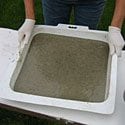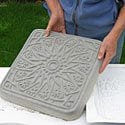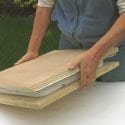what cement do you use to mold garden hands
Basic Instructions
TIME: approximately 15 to 30 minutes per stone
COST: approximately $i.00 per stepping stone, 40 cents per Edging Stone stone
MATERIALS:
• Wheelbarrow or all-purpose plastic utility tub.
• 60# purse of either pre-mix concrete or mortar mix.
• Shovel or pocket-sized garden spade.
• Rubber or latex gloves.
• Grit mask, particularly if working indoors without ventilation.
• Plastic sheeting.
• Mold release. Liquid vegetable oil such every bit canola and safflower.

Concrete Mold and Plaque Pouring
Optional: Atomic number 26 oxide pigments. Add to wet concrete, a few tablespoons of these
pigments to turn gray into shades of carmine, buff, brown and dark-green.
Important NOTES:
• I 60# purse of concrete yields approx. iii Stepping Stones or 7-10 Edging Stone stones.
• Do non use PAM or other sprays as a mold release; they don't cover evenly or thick enough.
Making Your Own Concrete Garden Stepping Stones
Stride 1.
First castor inner mold surface with mold release, applying with an inexpensive paintbrush. Remove backlog oil with a newspaper towel or dry paintbrush. Next, mensurate dry out physical or mortar mix in a wheelbarrow or utility tub. For square stepping stone molds, utilize approximately 7 ane/2 quarts of dry concrete (before the improver of water); for round molds, 6 quarts dry. Edging Stone molds volition crave approximately 3 quarts dry physical or mortar mix.

Add water slowly, stirring well between additions. The mixture should be the consistency of muffin or brownie concoction and "ridges" should class when a stick or paddle is run through. If the mixture is and so runny that these ridges don't announced, add a little more than dry concrete.
If using iron oxide pigments, add together now. Generally, 3-4 tablespoons paint per step stone and 1 i/2 tablespoons per Edging Stone rock volition produce a pleasing saturation. The colors will announced muted while the concrete is still wet, so resist adding actress pigment. Have notes on how much is used so that the color can exist duplicated or tweaked in future pours.
STEP 2.
Fill mold with 1/four″ to i/ii″ of concrete, just enough to embrace the design surface. To remove air bubbles from the concrete (which otherwise course pockmarks on the finished surface), lift one side of the mold ¼"-½" and tap lightly upwards and down on the worktable for a infinitesimal or then. Plough the mold 90 degrees and repeat, until all four sides accept been lifted and tapped down. Remember of this motion as a gentle vibration. And then fill the mold, tapping a few times to level physical.
STEP iii.
Comprehend filled mold with plastic sheeting and allow physical to harden in a cool (and level!) location for two days before removing from mold. Later on demolding, cure stone another week earlier setting in basis.
render to acme
NOTE: Moderate temperatures in the fifty's and 60'southward (degrees F) are platonic for curing concrete. During periods of extreme heat or
cold, cure stones in a basement or insulated garage.

Mix concrete to muffin or credibility concoction consistency

Partially fill up mold and tap
to remove air bubbless

Make full concrete to top and
tap to level concrete

Permit to harden, remove
from mold afterwards ii days
Placing Stepping Stones
If you've made stepping stones to use every bit a footpath, some grooming is now needed before placing them in the ground.
• Kickoff pace out the intended path, mark each footfall with a pebble.
• Center a finished stone on the marked spot then sprinkle flour along the stone's outside perimeter. Remove stone.
• Dig down approximately 3-4″ within the confines of the flour border, roughly leveling the lesser of the hole.
• Pour 1-two″ of sand into pigsty. Level sand.
• Place the stepping stone. Jiggle back and forth until rock sits firmly and evenly in place. To set up a stone higher or lower, simply add together or subtract sand.
Physical In Common cold Climates
Special consideration needs to be given to the durability of stepping stones in cold climates. Concrete is porous; any water which has soaked into the stone will freeze and expand during common cold winters, possibly creating fractures. Some ways to forbid cracking are:
Concrete sealants:
Found in hardware and dwelling comeback centers. They permeate the pores in concrete, helping form a h2o barrier. At that place are many sealants available on the market. Acrylic sealants are UV stable, inexpensive and like shooting fish in a barrel to employ simply have the softest, to the lowest degree durable terminate. Solvent-based acrylic sealants more often than not perform ameliorate than h2o-based products for outdoor utilise, are UV-stable, and are recommended for applications where a flat finish is desired. Water-based epoxy bonds well to concrete, is harder than acrylic sealants, but isn't UV-stable. For stones containing iron oxide pigments, UV sealants will assist maintain color.
Allow the stone to cure 10 days to 2 weeks before applying sealants. Concrete which has been completely painted with either concrete paint or patio paint need non be sealed.
Wire or nails:
Wire mesh (such every bit chicken wire) profoundly improves concrete forcefulness. Cut a sheet slightly smaller than the mold's diameter, lay apartment into mold half-filled with concrete, then make full mold to top. Some other easy reinforcement is a couple handfuls of galvanized nails sprinkled into wet physical as mold is existence filled; think of these as miniature rebar.
WELDBOND Universal Adhesive:
Weldbond brand can be found in hardware and home improvement centers. Mix 1 part Weldbond to v parts water; this will be approximately 4-5 ounces of Weldbond per stepping stone. Weldbond dramatically increases the strength of the physical (upward to 1700%).
Care Of Your Mold
Your molds should final 10-twenty pours, even more if given proper care. Hither are some tips:
• Practice not lift filled molds while the concrete is still wet. Although the mold's rim tin hold weight, repeated lifting will weaken the plastic. To movement a filled mold, slide plywood underneath for easier ship.

• Avert vigorous tapping when removing air bubbles; this can cause cracks in the plastic. Should a crack develop in the mold, fill information technology with epoxy or Bondo, institute at whatsoever hardware store. Apply these adhesives to the outer surface of the mold.
• Store molds in a cool, dry out place, away from estrus and light. Heat makes all plastic brittle.
• Create a plywood "sandwich." This technique will ensure the longest mold life possible by eliminating all stress on the plastic. To make a "sandwich", but cut two eighteen″ x 18″ pieces of plywood (1/2″ thickness is sufficient). Before filling mold with concrete, place 1 sheet of plywood underneath mold. When shaking out air bubbles, lift the edge of the forest (instead of mold lip) to vibrate the concrete. Later curing, de-mold the rock by sandwiching mold between two sheets of plywood and flipping over.
Source: https://gardenmolds.com/tutorials/step-by-step-instructions/
0 Response to "what cement do you use to mold garden hands"
Post a Comment